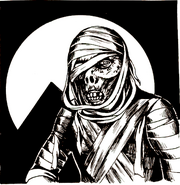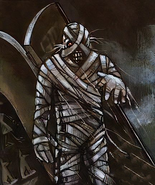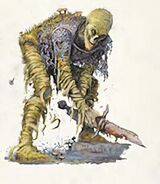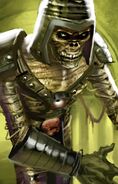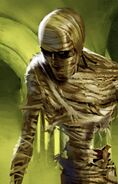Mummies were undead creatures created from a preserved mummified corpse animated by the dark gods of the desert.[3]
Description[]
The most common mummy appeared as a humanoid creature, wrapped in old strips of linen, damaged by rot and age. However different types of mummified creatures existed. They stood somewhere between 5 feet (1.5 meters) and 7 feet (2.1 meters) tall.[4] Many mummies carried a distinct aroma of the ingredients used in their creation. Such smells were emitted by cinnamon, ginger, saltpeter, roses, myrrh, frankincense, lye, wormwood, and pomegranate. While others carried less pleasant smells of upturned earth, decay, and vegetable rot. And rarely, mummies could smell of bread or yeast, wine, vinegar, and even roasted meats.[6][13]
Variants[]
- Creature mummy: These were made of corpses of animals and non-humanoids, such as centaurs[6], tlincallis[14], or crypt cats.[15] Creature mummies varied greatly and were similar to regular mummies, however, some more exotic creature mummies were preserved via being left in hot environments being baked by cruel sun, being dry-frozen, sealed in tar, various salves and magical substances, or even preserving magics or curses.[6]
- Crawling apocalypse: A creature that resembles a giant mummified octopus.[16][17]
- Greater mummy: These were mummified priests of a god who were imbued with dark magic.[18][19]
- Huecuva: Huecuva are created from divine or oath-bound creatures who have failed in their vows.[20]
- Mummy lord: Mummy lords are often potent spellcasters. They are found as guardians of the tombs of high lords, priests, and mages.[3][19][21]
- Pale master mummy: A powerful type of dangerous mummy that could be summoned via the summon greater undead spell.[22]
- Salt mummy: Ancient corpses of humanoids preserved by being buried in or near salt. Salt mummies were generally very evil when they were alive.[23][24]
- Spawn of Kyuss: a walking undead mummy or a Zombie infested with the taint of Kyuss.[25]
- Warrior mummy: A stronger variation of a common undead mummy, proficient in close combat and warrior skills that could put living warriors to shame.[19]
- Web mummy: A creature animated by tomb spiders' eggs[26] laid into humanoid corpses.[27]
Abilities[]
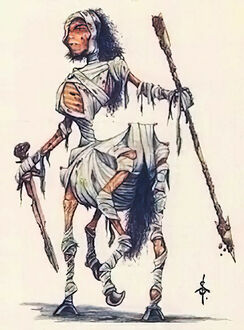
A centaur mummy.
Mummies caused fear in the living on sight, and any creature they touched was affected by a rotting curse called mummy rot.[3] The rot, if left uncured, could kill its host within 1-6 months. With each passing month, the victim suffered from the disease, their skin rotted more and more, and the natural healing rate significantly slowed down. This affliction could be alleviate via the cure disease[4] or break enchantment spells[3], while cure wounds was completely useless. When a creature died from the mummy rot, the disease destroyed the corpse within twelve seconds, leaving extremely little time to return them to life by magical means. A fully rotted corpse could not be resurrected by the raise dead spell.[4] Among other diseases that were carried by various mummified creatures were deadeye, heartsting, deathbite, and palsy.[6]
All mummies spread terror, forcing even the bravest creatures to flee in terror[19] or be paralyzed by the looming dread.[4]
These undead creatures could only be harmed by magical or enchanted weapons, and even these tools were only partially effective. Like many other undead, mummies were immune to spells and effects such as sleep, charm, hold,[4] poison, and paralysis,[5] while cold was completely useless when wielded against them. Fire, both magical and mundane, as well as holy water, posed significant danger to mummies.[4]
A mummy could be returned to life by a cleric with the use of the resurrection spell. However, it depended on the priest's abilities and the mummy's age. Remove curse did not affect them, while spells such as wish could return mummies to life.[4]
Behavior[]
Mummies were the undead guardians of tombs and vaults of honored dead (such as kings or nobility of the ancient world). They patrolled their homes with dedication, remaining alert for signs of tomb robbers or others who would defile their assigned lair.[3] In their state of undead existence, mummies felt hatred to all living things, attacking every creature in their way indiscriminately.[4]
Combat[]
Mummies were granted great physical strength, and their scabrous touch carried a virulent curse that acted as a disease, known as mummy rot.[3] Mummified creatures used their natural weapons with the unnatural undead strength to clobber, pummel, claw, or bite their opponents. However, more exotic mummified creatures retained some of the fearsome abilities they had in life.[6]
Ecology[]
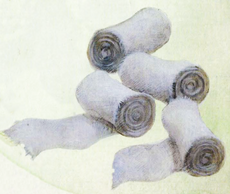
Fresh unused linen mummy wrappings.
Most mummies were not created by magical means and were simply embalmed nobles, heroes, and other important individuals.[4] In some cases, mummification and being turned into undead guardians was reserved for criminals or transgressors who wronged a powerful leader or priest.[1] After being interred, these mummified creatures, were known to spontaneously rise from tombs when their final resting places were disturbed. The forces that aided in the creation of these creatures could be unspeakable dark magics or greed of the interred person in life, unwilling to suffer grave robbers in death. This powerful feeling of greed could tap into the energies of the Positive Energy plane, transforming them into the walking dreadful undead beings.[4]
Due to their connection to the Positive Energy plane, mummies existed simultaneously on both Prime Material and Positive Energy planes.[4]
Like other undead, mummies were not natural creatures, did not need eat nor drink, and had no predators and natural enemies.[4][1]
Habitats[]
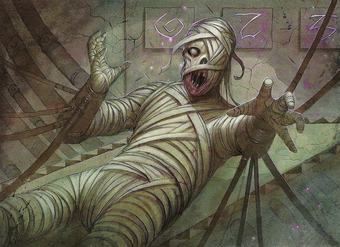
A mummy in the Tombs of Dayan raising to stop the intruders.
Most commonly, mummies could be found in dry desert locations on Toril. Sealed inside ancient tombs, catacombs, and burial chambers, and pyramids' cores. Most tombs that held mummified individuals were interred within complex crypts with traps and numerous rooms filled with the treasures, relics, and favorite items they possessed in life. These possessions often included pets, foods, aromatic oils. Tombs that were evil creatures' final resting place often included the mummies' slaves and family members killed and interred with their cruel masters.[4]
Circa 1340 DR, mummies could be encountered in the swamps outside the town of Phlan in the Moonsea region.[7]
Shambling and moldering mummies were encountered in Gauntlgrym circa 1479 DR.[8]
Wandering undead, including mummies, were known to plague Red Cliffs in the High Moor, and especially mummies created for bog burials could be encountered in the region's peat bogs.[9]
In Zakhara, mummies could be found in the catacombs under ruined Moradask, the city of Sun.[10]
In the Old Empires, mummies were a common undead occurrence in Mulhorand due to their mummification burial customs. Wandering mummy creatures could be encountered in the Great Vale and in civilized areas of the land at night and in the wastes.[11]
Beyond the Prime Material plane, mummies could be found in the Domains of Dread.[12]
Creation[]
The spell mummy creation animated a corpse into a mummy, but only for a short period of time.[28][29] The Baneite spell undeath after death allowed the worshipers of the deity to return to unlife after death in forms of several types of undead, including mummies.[30]
Traditional mummy was created via a long and arduous process of mummifying a body. The corpse that was to become a mummy was first soaked in a preservative substance, such as a carbonate of soda. The soaking was done over the course of several weeks. Then the body was covered with aromatics, such as spices and raisins. The body's hearts, brains, and liver were often removed and preserved in separate canopic jars and stored not far from the mummified body within the tomb. The body was thoroughly preserved wrapped in linen cloth strips that sometimes held gemstones affixed between the sheets.[4] Some mummies, often monstrous mummies' linens were dyed and soaked in additional preserving salves and tinctures of herbal nature.[6]
When mummies were created to serve as eternal guards via necromantic magics, the mummy wrappings were inscribed with magical symbols, and the ritual culminated in a dark magic incantation that created the undead creature. The sentry mummy became animated when specific conditions indicated in its creation were met. These conditions typically were trespassing in the mummy's tomb, theft, or offenses against the mummy's loved ones.[1]
Relations[]
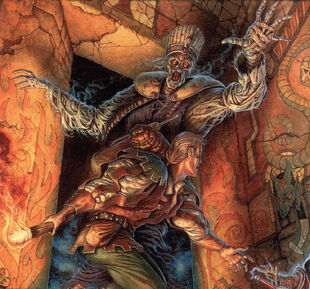
The legendary ancient guardian living mummy of Cursrah.
Raised animal mummies were known to serve as undead minions to more powerful beings, mummies, or other dangerous forms of intelligent undead, while monster mummies often were created to specifically serve as eternal guardians.[6]
Yuan-ti communities created malison mummies to serve as protectors often stationed within the snake cities, hideouts,[31] and temples of Zehir.[32]
Aspects of the kobold deity Kurtulmak were known to use mummies as guardians.[33]
The avatar of Jergal, the Lord of the End of Everything, took on the shape of a desiccated and mummified creature of some unknown ancient alien race.[34]
Usages[]
Mummy dust was a valued spell component used to create items enchanted with rot and disease,[4] such as breath of life[35] or undead summoning,[36] and mummy bone was one of known material component used in certain spells,[37] such as scare.[38]
A coloring powdered pigment from the Old Empires, known as "mummy brown," was originally created out of crushed and milled mummy remains.[37]
Mulhorandi mummy's tea were foul-smelling potions brewed using used mummy wrappings. These concoctions were used to alleviate various ailments, similarly to the effects of cure blindness or deafness and cure disease spells.[39]
Dust of the mummy was a powdered poison, sometimes used in trap making. The poison was a byproduct of the embalming process, distilled out of organs removed during the mummification. When inhaled, the dust of the mummy caused an infection of mummy rot disease. The effects of the poison could be elicited with a dose of mummy rot antidote.[40]
Mummy wrappings were a rare commodity, valued at 40 gold coins.[41]
History[]
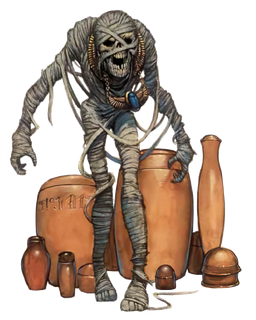
A risen mummy and its canopic jars.
In 1369 DR, an ancient magic-wielding mummy that dated back to −6048 DR was raised when its ancient home city of Cursrah was unearthed. The mummy was tasked with protecting the buried city's greatest treasures. It was later revealed that the mummified creature was ruled by the life energy of Tafir of the ancient Cursrah, while the body of Amenstar was turned into a unique living mummy, awake, intelligent, and alert. Subsequently, the powerful creature was turned into dust and rags.[42]
Circa 1375 DR, mummies, along with other undead, were in service of a vampire, Xedac of the Twisted Rune, who was sent into Undermountain to steal an enchanted runestone created by Halaster Blackcloak.[43]
Notable Mummies[]
- Azmaer Dhuurniv, the powerful drow mummy leader of the Twisted Tower circa 1375 DR.[44]
- Chon Vrael, a mummy lord high priest from Thay circa the times the Spellplague.[45]
- El Sadhara, a powerful mummified priestess of Akadi circa 1370 DR.[46]
- Gorka Tharn, a duergar mummy lord interred in the Runestone Caverns of Undermountain.[21]
- Hssthak, the last of the sarrukh race, preserved in a powerful spellcasting mummy form.[47]
- Hund Hiilgauntlet, a member of the Hiilgauntlet family of Waterdeep who turned himself into a mummy of the Arcane Chambers in Undermountain.[48]
- Kahras, the Mummy of Memnonnar, a feared and famous agent of the Twisted Rune.[49]
- Kesefehon, an elven commander of Myth Drannor who died of an unknown disease that turned him into a mummy after his death. In 1369 DR, he was trapped in his undead state inside his crypt in Myth Drannor's Polyandrium.[50]
- Khalif, the mummy animated by Barjin of Talona before his death in 1361 DR.[51]
- Shaddad the Terror, a mummy created by a genie's curse, interred in Zakharan Tomb of Shaddad.[52]
- Shaxan Kazraat, a Netherese mummy lord whose sarcophagus was a part of Iymrith's horde circa 1488 DR.[53]
- Telarthir, an ancient and long forgotten ruler who rose as a warrior mummy in 1372 DR to kill intruders in his crypt, hidden in the Lonely Barrens of Delimbiyr Vale.[54]
- Thadrack, a fungus-infested mummy from the ruined city of Multum in the Underdark.[55]
- Valin Sarnaster, a mummy lord who attempted to achieve godhood.[56]
Gallery[]
Appendix[]
See also[]
Appearances[]
- Adventures
- Desert of Desolation • Ruins of Adventure • Haunted Halls of Eveningstar • Dungeon #19: "House of Cards" • City of Gold • Blood Charge • The Genie's Terror • Pool of Radiance: Attack on Myth Drannor • Shadowdale: The Scouring of the Land • Anauroch: The Empire of Shade • Expedition to Undermountain • Tombs of Dayan • Ghosts of Dragonspear Castle • Vault of the Dracolich • The Rise of Tiamat • Storm King's Thunder • The Orrery of the Wanderer • Waterdeep: Dragon Heist • Waterdeep: Dungeon of the Mad Mage • Icewind Dale: Rime of the Frostmaiden • The Canopic Being • The Scrivener's Tale • In Scarlet Flames
- Referenced only
- Infernal Machine Rebuilt
- Novels
- Star of Cursrah • The Ring of Winter • Canticle • In Sylvan Shadows • The Simbul's Gift • Easy Betrayals • Promise of the Witch-King • Road of the Patriarch • Storm of the Dead • Sands of the Soul • Unholy • Neverwinter • Plague of Spells
- Referenced only
- Mortal Consequences • Cormyr: A Novel • The Temptation of Elminster • The Nether Scroll • The Threat from the Sea • The Chaos Curse • The Alabaster Staff • The Floodgate • The Wizardwar • The Spectral Blaze • The Adversary
- Video Games
- Pool of Radiance • Gateway to the Savage Frontier • Treasures of the Savage Frontier • Dungeon Hack • Al-Qadim: The Genie's Curse • Descent to Undermountain • Icewind Dale • Icewind Dale: Trials of the Luremaster • Neverwinter Nights series (Neverwinter Nights • Neverwinter Nights: Hordes of the Underdark • Neverwinter Nights: Darkness over Daggerford • Neverwinter Nights 2: Storm of Zehir) • Baldur's Gate: Siege of Dragonspear
- Board Games
- Mertwig's Maze
- Card Games
- AD&D Trading Cards • Dragonfire (Corruption in Calimshan)
- Game Books
- Knight of the Living Dead
- Licensed Adventures & Organized Play
- Ship of Doom • Shadows Rising • See No Evil • Monster Mash • Isle of the End • Pilgrimage • Dwarf in the Fold • Another Serious Matter • Approaching Doom • Battlefield: Procampur • Uncertain Scrutiny • Putting the Dead to Rest • Crypt of the Dark Kiss • The Skull Square Murders • Consequences of Choice • Assault on Maerimydra • In Scarlet Flames
Further Reading[]
- Tom Moldvay (October 1993). “Beyond the Grave”. In Roger E. Moore ed. Dragon #198 (TSR, Inc.), pp. 20–29;39.
- Terry Edwards (October 2002). “The Ecology of...: Shrouded in Death”. In Jesse Decker ed. Dragon #300 (Paizo Publishing, LLC), pp. 78–83.
References[]
- ↑ 1.0 1.1 1.2 1.3 1.4 1.5 Mike Mearls, Jeremy Crawford, Christopher Perkins (2014-09-30). Monster Manual 5th edition. Edited by Scott Fitzgerald Gray. (Wizards of the Coast), pp. 228–229. ISBN 978-0786965614.
- ↑ Mike Mearls, Stephen Schubert, James Wyatt (June 2008). Monster Manual 4th edition. (Wizards of the Coast), p. 192. ISBN 978-0-7869-4852-9.
- ↑ 3.0 3.1 3.2 3.3 3.4 3.5 3.6 3.7 3.8 3.9 Skip Williams, Jonathan Tweet, Monte Cook (July 2003). Monster Manual v.3.5. (Wizards of the Coast), pp. 190–191. ISBN 0-7869-2893-X.
- ↑ 4.00 4.01 4.02 4.03 4.04 4.05 4.06 4.07 4.08 4.09 4.10 4.11 4.12 4.13 4.14 4.15 4.16 4.17 4.18 4.19 Doug Stewart (June 1993). Monstrous Manual. (TSR, Inc), p. 261. ISBN 1-5607-6619-0.
- ↑ 5.0 5.1 Gary Gygax (December 1977). Monster Manual, 1st edition. (TSR, Inc), p. 72. ISBN 0-935696-00-8.
- ↑ 6.00 6.01 6.02 6.03 6.04 6.05 6.06 6.07 6.08 6.09 6.10 Jon Pickens ed. (1995). Monstrous Compendium Annual Volume Two. (TSR, Inc.), pp. 89–90. ISBN 0-7869-0199-3.
- ↑ 7.0 7.1 Elaine Cunningham (March 2002). The Wizardwar. (Wizards of the Coast), chap. 16. ISBN 978-0786927043.
- ↑ 8.0 8.1 Matt Sernett, Erik Scott de Bie, Ari Marmell (August 2011). Neverwinter Campaign Setting. Edited by Tanis O'Connor. (Wizards of the Coast), p. 128. ISBN 0-7869-5814-6.
- ↑ 9.0 9.1 Tim Beach (October 1995). “Encounter Tables”. In Julia Martin ed. Elminster's Ecologies Appendix II (TSR, Inc). ISBN 0786901713.
- ↑ 10.0 10.1 Steve Kurtz (1994). Al-Qadim: Cities of Bone: Campaign Guide. (TSR, Inc), p. 32. ISBN 1-56076-847.
- ↑ 11.0 11.1 Scott Bennie (February 1990). Old Empires. Edited by Mike Breault. (TSR, Inc.), p. 87. ISBN 978-0880388214.
- ↑ 12.0 12.1 William W. Connors (1996). Monstrous Compendium - Ravenloft Appendices I & II. (TSR, Inc.), p. 70. ISBN 0786903929.
- ↑ Clayton Emery (January 1999). Star of Cursrah. (Wizards of the Coast), chap. 7. ISBN 0-7869-1322-3.
- ↑ Greg A. Vaughan, Skip Williams, Thomas M. Reid (November 2007). Anauroch: The Empire of Shade. (Wizards of the Coast), p. 69. ISBN 0-7869-4362-9.
- ↑ Greg A. Vaughan, Skip Williams, Thomas M. Reid (November 2007). Anauroch: The Empire of Shade. (Wizards of the Coast), p. 70. ISBN 0-7869-4362-9.
- ↑ Jennifer Clarke-Wilkes, Bruce R. Cordell and JD Wiker (March 2005). Sandstorm. (Wizards of the Coast), p. 143. ISBN 0-7869-3655-X.
- ↑ Greg A. Vaughan, Skip Williams, Thomas M. Reid (November 2007). Anauroch: The Empire of Shade. (Wizards of the Coast), p. 99. ISBN 0-7869-4362-9.
- ↑ William W. Connors (1991). Monstrous Compendium Ravenloft Appendix. (TSR, Inc.), p. 41. ISBN 9781560761082.
- ↑ 19.0 19.1 19.2 19.3 BioWare (June 2002). Designed by Brent Knowles, James Ohlen. Neverwinter Nights. Atari.
- ↑ Douglas Niles and Michael Dobson (1988). The Throne of Bloodstone. (TSR, Inc), p. 34. ISBN 0-8803-8560-X.
- ↑ 21.0 21.1 Christopher Perkins (November 2018). Waterdeep: Dungeon of the Mad Mage. Edited by Jeremy Crawford. (Wizards of the Coast), p. 257. ISBN 978-0-7869-6626-4.
- ↑ BioWare (December 2003). Designed by Brent Knowles. Neverwinter Nights: Hordes of the Underdark. Atari.
- ↑ Andrew Finch, Gwendolyn Kestrel, Chris Perkins (August 2004). Monster Manual III. (Wizards of the Coast), p. 146. ISBN 0-7869-3430-1.
- ↑ Lisa Smedman (September 2007). Storm of the Dead. (Wizards of the Coast). ISBN 978-0-7869-4701-0.
- ↑ Bruce R. Cordell, Gwendolyn F.M. Kestrel, Jeff Quick (October 2003). Underdark. (Wizards of the Coast), p. 5. ISBN 0-7869-3053-5.
- ↑ Cryptic Studios (June 2013). Neverwinter. Perfect World Entertainment.
- ↑ Gwendolyn F.M. Kestrel (July 2006). Monster Manual IV. (Wizards of the Coast), pp. 164–165. ISBN 0-7869-3920-6.
- ↑ Scott Bennie (February 1990). Old Empires. Edited by Mike Breault. (TSR, Inc.), p. 74. ISBN 978-0880388214.
- ↑ Mark Middleton et al (March 1998). Wizard's Spell Compendium Volume Three. (TSR, Inc), p. 604. ISBN 978-0786907915.
- ↑ Jon Pickens et al. (1999). Priest's Spell Compendium Volume Three. (TSR, Inc), p. 670. ISBN 9780786913596.
- ↑ Mike Mearls, et al. (November 2016). Volo's Guide to Monsters. Edited by Jeremy Crawford, et al. (Wizards of the Coast), p. 102. ISBN 978-0786966011.
- ↑ Mike Mearls, Stephen Schubert, James Wyatt (June 2008). Monster Manual 4th edition. (Wizards of the Coast), p. 193. ISBN 978-0-7869-4852-9.
- ↑ Robert Wiese (2007-02-16). Fiendish Aspects II (Zipped PDF). Wizards of the Coast. p. 6. Archived from the original on 2016-11-01. Retrieved on 2018-09-08.
- ↑ Eric L. Boyd (September 1997). Powers & Pantheons. Edited by Julia Martin. (TSR, Inc.), p. 32. ISBN 978-0786906574.
- ↑ Mark Middleton et al. (1999). Priest's Spell Compendium Volume One. (TSR, Inc), p. 86. ISBN 9780786913596.
- ↑ Mark Middleton et al (September 1998). Wizard's Spell Compendium Volume Four. (TSR, Inc), p. 969. ISBN 978-0786912094.
- ↑ 37.0 37.1 Lynn Abbey (September 2000). The Nether Scroll. (Wizards of the Coast), chap. 14. ISBN 0-7869-1566-8.
- ↑ David "Zeb" Cook (April 1995). Player's Handbook 2nd edition (revised). (TSR, Inc.), p. 187. ISBN 0-7869-0329-5.
- ↑ Black Isle Studios (June 2000). Designed by Matt Norton. Icewind Dale. Interplay.
- ↑ Bart Carroll (November 11, 2019). Infernal Machine Rebuild. Edited by Scott Fitzgerald Gray. (Wizards of the Coast), p. 93.
- ↑ Richard Baker (1996). Player's Option: Spells & Magic. (TSR, Inc), p. 75. ISBN 0-7869-0394-5.
- ↑ Clayton Emery (January 1999). Star of Cursrah. (Wizards of the Coast), chap. 16. ISBN 0-7869-1322-3.
- ↑ Eric L. Boyd, Ed Greenwood, Christopher Lindsay, Sean K. Reynolds (June 2007). Expedition to Undermountain. Edited by Bill Slavicsek. (Wizards of the Coast), p. 193. ISBN 978-0-7869-4157-5.
- ↑ Richard Baker, Eric L. Boyd, Thomas M. Reid (July 2007). Shadowdale: The Scouring of the Land. (Wizards of the Coast), p. 102. ISBN 07-8694-039-5.
- ↑ Bruce R. Cordell, Ed Greenwood, Chris Sims (August 2008). Forgotten Realms Campaign Guide. Edited by Jennifer Clarke Wilkes, et al. (Wizards of the Coast), p. 181. ISBN 978-0-7869-4924-3.
- ↑ Steven E. Schend, Dale Donovan (September 1998). Empires of the Shining Sea. Edited by Julia Martin. (TSR, Inc.), p. 79. ISBN 0-7869-1237-5.
- ↑ Ed Greenwood, Eric L. Boyd, Darrin Drader (July 2004). Serpent Kingdoms. (Wizards of the Coast), p. 96. ISBN 0-7869-3277-5.
- ↑ Ed Greenwood (1991). “Campaign Guide to Undermountain”. In Steven E. Schend ed. The Ruins of Undermountain (TSR, Inc.), p. 65. ISBN 1-5607-6061-3.
- ↑ Steven E. Schend, Dale Donovan (September 1998). Empires of the Shining Sea. Edited by Julia Martin. (TSR, Inc.), p. 184. ISBN 0-7869-1237-5.
- ↑ Sean K. Reynolds (2000). Pool of Radiance: Attack on Myth Drannor. Edited by Michele Carter. (Wizards of the Coast), p. 31. ISBN 0-7869-1710-5.
- ↑ R.A. Salvatore (March 2009). Canticle. (Wizards of the Coast), chap. 7, pp. 111–112. ISBN 978-0-7869-505202.
- ↑ Steve Kurtz (1994). Al-Qadim: Cities of Bone: Adventure Book. (TSR, Inc), p. 17. ISBN 1-56076-847.
- ↑ Christopher Perkins, et al. (September 2016). Storm King's Thunder. Edited by Kim Mohan, Michele Carter. (Wizards of the Coast), p. 230. ISBN 978-0-7869-6600-4.
- ↑ Ossian Studios (June 2018). Neverwinter Nights: Darkness over Daggerford. Beamdog.
- ↑ Bruce R. Cordell, Gwendolyn F.M. Kestrel, Jeff Quick (October 2003). Underdark. (Wizards of the Coast), p. 186. ISBN 0-7869-3053-5.
- ↑ Jennifer Kretchmer, Scott Fitzgerald Gray, Christopher Perkins (March 2021). “The Canopic Being”. In Scott Fitzgerald Gray, Christopher Perkins eds. Candlekeep Mysteries (Wizards of the Coast), p. 182. ISBN 978-0-7869-6722-3.


